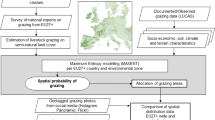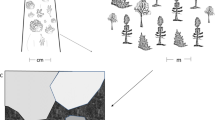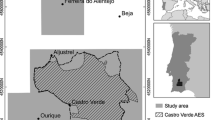Abstract
Most spatial models of grazing assume a global search; that is, the entire paddock or landscape is available to grazers. These `unconstrained' models characterize landscape patches based on absolute properties (i.e., without regard for how individual grazers are situated within them). In most of East Africa cattle are herded and must start and end each day's grazing at their enclosure. Thus, global search is not a realistic assumption. This implies that the relative location of a patch may be more important than its absolute properties because its quality depends not only on the properties of the patch itself, but also on its location relative to home and to water. Using data from 73 full-day herd follows among a group of agropastoralists in western Tanzania, I build and test an unconstrained model and compare its analytical utility and predictive power to a `central-place' model that defines the landscape relative to herders' homes (the central place) and dry season water. The central-place model provides analytical insights into the grazing system that are not apparent when using an unconstrained model, and it explains more of the variance in grazing intensity. Because many types of resources are collected around a focal point, central-place models should have wide applicability for analyzing and modeling many kinds of resource use, particularly in the developing world.
Similar content being viewed by others
References
Abrahams, R. G. 1967. The Peoples of Greater Unyamwezi, Tanzania. International African Institute, London, UK.
Anderson, D. C. 1996. A Spatially-Explicit Model of Search Path and Soil Disturbance by a Fossorial Herbivore. Ecological Modelling 89: 99–108.
Århem, K. 1985. Pastoral Man in the Garden of Eden: The Maasai of the Ngorongoro Conservation Area, Tanzania. University of Uppsala, Uppsala, Sweden.
Bailey, D. W., J. E. Gross, E. A. Laca, L. R. Rittenhouse, M. B. Coughenour, D. M. Swift and P. L. Sims. 1996. Mechanisms that Result in Larger Herbivore Grazing Distribution Patterns. Journal of Range Management 49: 386–400.
Baker, W. L. 1995. Longterm Response of Disturbance Landscapes to Human Intervention and Global Change. Landscape Ecology 10: 143–159.
Bettinger, R. L., R. Malhi and H. McCarthy. 1997. Central place models of acorn and mussel processing. Journal of Archaeological Science 24: 887–899.
Bignal, E. M. 1998. Using an ecological understanding of farmland to reconcile nature conservation requirements, EU agriculture policy and world trade agreements. Journal of Applied Ecology 35: 949–954.
Bird, D. W. and R. L. Bliege Bird. 1997. Contemporary Shell-fish Gathering Strategies among the Meriam of the Torres Strait Islands, Australia: Testing the Predictions of a Central Place Foraging Model. Journal of Archaeological Science 24: 39–63.
Borner, M. 1984. The Increasing Isolation of Tarangire National Park. Oryx 19: 91–96.
Brandon, K. 1998. Perils to Parks: The Social Context of Threats. in Parks in peril: people, politics, and protected areas. Pp. 415–439. Edited by K. Brandon, K. H. Redford and S. E. Sanderson. Island Press, Nature Conservancy, Washington, D.C., USA.
Brandström, P. 1985. The Agro-Pastoral Dilemma: Underutilization or Overexploitation of Land Among Sukuma of Tanzania. African Studies Programme, University of Uppsala, Uppsala, Sweden.
Broten, M. D. and M. Said. 1995. Population trends of ungulates in and around Kenya's Masai Mara Reserve. in Serengeti II: Dynamics, Management and Conservation of an Ecosystem. Pp. 169–193. Edited by A. R. E. Sinclair and P. Arcese. University of Chicago Press, Chicago.
Brown, L. H. 1971. The Biology of Pastoral Man as a Factor in Conservation. Biological Conservation 3: 93–100.
Burkey, T. V. 1995. Faunal Collapse in East African Game Reserves Revisited. Biological Conservation 71: 107–110.
Campbell, K. and H. Hofer. 1995. People and Wildlife: Spatial Dynamics and Zones of Interaction. in Serengeti II Dynamics, Management and Conservation of an Ecosystem. Pp. 534–570. Edited by A. R. E. Sinclair and P. Arcese. University of Chicago Press, Chicago.
Caro, T. M. 1999a. Abundance and distribution of mammals in Katavi National Park, Tanzania. African Journal of Ecology 37: 305–313.
Caro, T. M. 1999b. Densities of mammals in partially protected areas: The Katavi ecosystem of western Tanzania. Journal of Applied Ecology 36: 205–217.
Casimir, M. J. and A. Rao. 1998. Sustainable herd management and the tragedy of no man's land: An analysis of west Himalayan pastures using remote sensing techniques. Human Ecology 26: 113–134.
Clayton, L., M. Keeling and E. J. Milner Gulland. 1997. Bringing home the bacon: A spatial model of wild pig hunting in Sulawesi, Indonesia. Ecological Applications 7: 642–652.
Conant, F. P. 1982. Thorns Paired, Sharply Recurved: Cultural Controls and Rangeland Quality in East Africa. in Desertification and Development. Dryland Ecology in Social Perspective. Edited by S. B. and H. S. Mann. Academic Press, London, UK.
Coppock, D. L., J. E. Ellis and D. M. Swift. 1986. Livestock Feeding Ecology and Resource Utilization in a Nomadic Pastoral Ecosystem. Journal of Applied Ecology 23: 573–583.
Coppolillo, P. B. 2000. The landscape ecology of pastoral herding: Spatial analysis of land use and livestock production in East Africa. Human Ecology: 28: 527–560.
Coughenour, M. B. 1991. Spatial Components of Plant-Herbivore Interactions in Pastoral, Ranching, and Native Ungulate Ecosystems. Journal of Range Management 44: 530–542.
Coughenour, M. B., J. E. Ellis, D. M. Swift, D. L. Coppock, K. Galvin, J. T. McCabe and T. C. Hart. 1985. Energy Extraction and Use in a Nomadic Pastoral Ecosystem. Science 230: 619–625.
Covich, A. P. 1976. Analyzing Shapes of Foraging Areas: Some Ecological and Economic Theories. Annual Review of Ecology and Systematics 7: 235–257.
Cuthill, I. C. and A. Kacelnik. 1990. Central Place foraging: A Reappraisal of the ‘Loading Effect’. Animal Behavior 40: 1087–1101.
Dahl, G. and A. Hjort. 1976. Having Herds. Pastoral Herd Growth and Household Economy. University of Stockholm, Stockholm, Sweden.
DeAngelis, D. L., J. C. Waterhouse, W. M. Post and R. V. O'Neill. 1985. Ecological Modelling and Disturbance Evaluation. Ecological Modelling 29: 399–419.
Dodd, J. L. 1994. Desertification and Degradation in Sub-Saharan Africa Livestock. Bioscience 44: 28–34.
du Toit, J. T. and D. H. M. Cumming. 1999. Functional Significance of Ungulate Diversity in African Savannas and the Ecological Implications of the Spread of Pastoralism. Biodiversity and Conservation 8: 1643–1661.
East, R. 1981. Species-Area Curves and Populations of LargeMammals in African Savanna Reserves. Biological Conservation 21: 111–126.
Eldridge, J. D. and J. P. Jones. 1991. Warped Space – a Geography of Distance Decay. Professional Geographer 43: 500–511.
Ellis, J. E. and M. B. Coughenour. 1996. The Savanna Integrated Modeling System. International Workshop on Sustainable Use of Rangelands and Desertification Control, Jeddah, Soudi Arabia.
Ellis, J. E. and D. M. Swift. 1988. Stability of African Pastoral Ecosystems: Alternate Paradigms and Implications for Development. Journal of Range Management 41: 450–459.
Eltringham, S. K., I. A. Cooksey, W. J. B. Dixon, N. E. Raine, C. J. Sheldrick, N. C. McWilliam and M. J. Packer. 1998. Large Mammals of Mkomazi. in Mkomazi: The Ecology, Biodiversity and Conservation of a Tanzanian Savanna. Pp. 485–504. Edited by M. Coe, N. C. McWilliam, G. Stone and M. J. Packer. Royal Geographic Society (with The Institute of British Geographers), London, UK.
Enghoff, M. 1990. Wildlife Conservation, Ecological Strategies and Pastoral Communities. Nomadic Peoples 25–27: 93–107.
Estes, R. D. 1991. The Behavior Guide To African Mammals. University of California Press, Berkeley, USA.
Fernandez-Gimenez, M. E. 1999. Reconsidering the role of absentee herd owners: A view from Mongolia. Human Ecology 27: 1–27.
Forman, R. T. T. 1995. Land mosaics: the ecology of landscapes and regions. Cambridge University Press, Cambridge/New York.
Forman, R. T. T. and S. K. Collinge. 1997. Nature conserved in changing landscapes with and without spatial planning. Landscape and Urban Planning 37: 129–135.
Fox, J., P. Yonzon and N. Podger. 1996. Mapping Conflicts Between Biodiversity and Human Needs in Lantang National Park, Nepal. Conservation Biology 10: 562–569.
Galaty, J. G. 1988. Pastoral and Agropastoral Migration in Tanzania: Factors of Economy, Ecology and Demography in Cultural Perspective. in Production and Autonomy. Pp. 163–183. Edited by Bennett, J. W. and Bower, J. R. Lanham: University Press of America: Society for Economic Anthropology, 1988.
Galaty, J. G. and D. L. Johnson. 1990. Introduction: Pastoral Systems in Global Perspective. in The World of Pastoralism: Herding Systems in a Global Perspective. Edited by J. G. Galaty and D. L. Johnson. Belhaven Press, New York, NY, USA.
Hackel, J. D. 1999. Community conservation and the future of Africa's wildlife. Conservation Biology 13: 726–734.
Haggett, P., A. E. Frey and A. D. Cliff. 1977. Locational analysis in human geography. Arnold, London, UK.
Haynes, K. E. and A. S. Fotheringham. 1984. Gravity and Spatial Interaction Models. Sage Publications, Beverly Hills, CA, USA.
Hill, D. H. 1995. The Cattle and Buffalo of Africa: Management. Outlook on Agriculture 24: 155–161.
Homewood, K. M. and W. A. Rodgers. 1984. Pastoralism and Conservation. Human Ecology 12: 431–441.
Homewood, K. M. and W. A. Rodgers. 1991. Maasailand Ecology: Pastoralist Development and Wildlife Conservation in Ngorongoro, Tanzania. Cambridge University Press, Cambridge, UK.
Kacelnik, A. 1984. Central Place Foraging in Starlings (Sturnus vulgaris): Patch Residence Time. Journal of Animal Ecology 53: 283–299.
Kahurananga, J. and F. Silkiluwasha. 1997. The migration of zebra and wildebeest between Tarangire National Park and Simanjiro Plains, northern Tanzania, in 1972 and recent trends. African Journal of Ecology 35: 179–185.
Kepe, T. and I. Scoones. 1999. Creating grasslands: Social institutions and environmental change in Mkambati area, South Africa. Human Ecology 27: 29–53.
Kremen, C., A. M. Merenlender and D. D. Murphy. 1994. Ecological Monitoring – a Vital Need For Integrated Conservation and Development Programs in the Tropics. Conservation Biology 8: 388–397.
Kremen, C., I. Raymond and K. Lance. 1998. An Interdisciplinary Tool for Monitoring Conservation Impacts in Madagascar. Conservation Biology 12: 549–563.
Lamprey, H. F. 1964. Estimation of the Large Mammal Densities, Biomass and Energy Exchange in the Taringire Game Reserve and Masai Steppe in Tanzania. East African Wildlife Journal 1: 1–46.
Lawrence, D., D. R. Peart and M. Leighton. 1998. The Impact of Shifting Cultivation on a Rainforest Landscape inWest Kalimantan: Spatial and Temporal Dynamics. Landscape Ecology 13: 135–148.
Lewis, D. M. 1995. Importance of GIS to Community-Based Management of Wildlife: Lessons From Zambia. Ecological Applications 5: 861–871.
Lindsay, W. K. 1989. Integrating Parks and Pastoralists: Some Lessons from Amboseli. in Conservation in Africa. Pp. 149–167. Edited by Anderson, D. and Grove, R. Cambridge University Press, New York, USA.
Little, P. D. 1996. Pastoralism, Biodiversity, and the Shaping of Savanna Landscapes in East Africa. Africa 66: 37–51.
McCabe, J. T. 1990. Turkana Pastoralism: A Case Against the Tragedy of the Commons. Human Ecology 18: 81–103.
McCabe, J. T., S. Perkin and C. Schofield. 1992. Can Conservation and Development Be Coupled Among Pastoral People: An Examination of the Maasai of Ngorongoro Crater, Tanzania. Human Organization 51: 353–366.
McIntyre, S. and R. Hobbs. 1999. A Framework for Conceptualizing Human Effects on Landscapes and Its Relevance to Management and Research Models. Conservation Biology 13: 1282–1292.
Meir, A. and H. Tsoar. 1996. International Borders and Range Ecology – the Case of Grazing. Human Ecology 24: 39–64.
Metcalfe, D. and K. R. Barlow. 1992. A Model For Exploring the Optimal Trade-Off Between Field Processing and Transport. American Anthropologist 94: 340–356.
Miller, R. I. and L. D. Harris. 1977. Isolation and Extirpations in Wildlife Reserves. Biological Conservation 12: 311–315.
Mishra, C. 1997. Livestock depredation by large carnivores in the Indian trans-Himalaya: conflict perceptions and conservation prospects. Environmental Conservation 24: 338–343.
Moen, R., J. Pastor and Y. Cohen. 1997. A Spatially Explicit Model of Moose Foraging and Energetics. Ecology 78: 505–521.
Mwalyosi, R. B. B. 1992. Influence of Livestock Grazing On Range Condition in South-West Masailand, Northern Tanzania. Journal of Applied Ecology 29: 581–588.
Newmark, W. D. 1996. Insularization of Tanzanian parks and the local extinction of large mammals. Conservation Biology 10: 1549–1556.
Nyerges, A. E. 1980. Traditional Pastoralism and Patterns of Rangeland Degradation. in Browse in Africa. The Current State of Knowledge. Pp. 465–471. Edited by H. N. Le Houérou. International Livestock Center for Africa, Addis Ababa, Ethiopia.
Obot, E. A., M. Oyatogun and M. Wari. 1989. Response of Woody Vegetation of Nweri Grazing Reserve to Utilization by Nomadic Livestock. Environmental Conservation 16: 165–169.
Orians, G. H. and N. E. Pearson. 1979. On the Theory of Central Place Foraging. in Analysis of Ecological Systems. Edited by D. J. Horn, R. D. Mitchell and C. R. Stairs. Ohio State University Press, Columbus, OH, USA.
Peden, D. G. 1987. Livestock and Wildlife Population Distributions in Relation to Aridity and Human Populations in Kenya. Journal of Range Management 40: 67–71.
Percival, S. M., W. J. Sutherland and P. R. Evans. 1996. A spatial depletion model of the responses of grazing wildfowl to the availability of intertidal vegetation. Journal of Applied Ecology 33: 979–992.
Pickup, G. 1994. Modelling Patterns of Defoliation by Grazing Animals in Rangelands. Journal of Applied Ecology 31: 231–246.
Pickup, G. and G. N. Bastin. 1997. Spatial distribution of cattle in arid rangelands as detected by patterns of change in vegetation cover. Journal of Applied Ecology 34: 657–667.
Pratt, D. J., P. J. Greenway and M. D. Gwynne. 1966. A Classification of East African Rangeland. Journal of Applied Ecology 3: 369–382.
Preston, R. E. 1992. Christallers Research On the Geography of Administrative Areas. Progress in Human Geography 16: 523–539.
Prins, H. H. T. 1992. The Pastoral Road to Extinction: Competition BetweenWildlife and Traditional Pastoralism in East Africa. Environmental Conservation 19: 117–123.
Runyoro, V. A., H. Hofer, E. B. Chausi and P. D. Moehlman. 1995. Long Term Trends in the Herbivore Poplulations of the Ngorongoro Crater, Tanzania. in Serengeti II: Dynamics, Management and Conservation of an Ecosystem. Pp. 146–168. Edited by A. R. E. Sinclair and P. Arscese. University of Chicago Press, Chicago, IL, USA.
Saberwal, V. K. 1996. Pastoral Politics: Gaddi Grazing, Degradation and Biodiversity Conservation in Himachal Pradesh, India. Conservation Biology 10: 741–749.
Schoener, T.W. 1983. Simple Models of Optimal Feeding-Territory Size: A Reconcilliation. The American Naturalist 121: 608–629.
Senft, R. L., L. R. Rittenhouse and R. G. Woodmansee. 1983. The Use of Regression Models to Predict Spatial Patterns of Cattle Behavior. Journal of Range Management 36: 553–557.
Senft, R. L., L. R. Rittenhouse and R. G. Woodmansee. 1985a. Factors Influencing Patterns of Cattle Grazing Behavior on Shortgrass Steppe. Journal of Range Management 38: 82–87.
Senft, R. L., L. R. Rittenhouse and R. G. Woodmansee. 1985b. Factors Influencing Selection of Resting Sites by Cattle on Shortgrass Steppe. Journal of Range Management 38: 295–299.
Shaffer, R. 1989. Community Economics: Economic Structure and Change in Smaller Communities. Iowa State University Press, Ames, Iowa, USA.
Shugart, H. H. 1998. Terrestrial ecosystems in changing environments. Cambridge University Press, Cambridge, UK.
Sinclair, A. R. E. and J. M. Fryxell. 1985. The Sahel of Africa: Ecology of a Disaster. Canadian Journal of Zoology 63: 987–994.
Soule, M. E., B. A. Wilcox and C. Holtby. 1979. Benign Neglect: A Model of Faunal Collapse in the Game Reserves of East Africa. Biological Conservation 15: 259–272.
Spencer, P. 1973. Nomads in Alliance. Symbiosis and Growth Among the Rendille and Samburu of Kenya. Oxford University Press, London, UK.
Stafford Smith, M. 1988. Modeling: Three Approaches to Predicting How Herbivore Impact is Distributed in Rangelands. New Mexico Agricultural Experiment Station, Las Cruces.
Stevens, S., Ed. 1997. Conservation Through Cultural Survival: Indigenous Peoples and Protected Areas. Island Press, Washington D.C., USA.
Terman, M. R. 1997. Natural links: naturalistic golf courses as wildlife habitat. Landscape and Urban Planning 38: 183–197.
Turner, M. D. 1998a. Long-term effects of daily grazing orbits on nutrient availability in Sahelian West Africa: 2. Effects of a phosphorus gradient on spatial patterns of annual grassland production. Journal of Biogeography 25: 683–694.
Turner, M. D. 1998b. Long-term effects of daily grazing orbits on nutrient availability in Sahelian West Africa: I. Gradients in the chemical composition of rangeland soils and vegetation. Journal of Biogeography 25: 669–682.
Turner, M. G., Y. Wu, W. H. Romme and L. L. Wallace. 1993. A Landscape Simulation Model of Winter Foraging by Large Ungulates. Ecological Modelling 69: 163–184.
TWCM. 1992. Katavi-Rukwa census, November 1991, Tanzania Wildlife Conservation Monitoring, Arusha, Tanzani.
Ward, D., B. T. Ngairorue, J. Kathena, R. Samuels and Y. Ofran. 1998. Land degradation is not a necessary outcome of communal pastoralism in arid Namibia. Journal of Arid Environments 40: 357–371.
Weber, G. E., F. Jeltsch, N. Van Rooyen and S. J. Milton. 1998. Simulated Long-Term Vegetation Response to Grazing Heterogeneity in Semi-Arid Rangelands. Journal of Applied Ecology 35: 687–699.
Western, D. 1975. Water Availability and Its Influence on the Structure and Dynamics of a Savannah Mammal Community. East African Wildlife Journal 13: 265–286.
Western, D. 1994. Ecosystem Conservation and Rural Development: The Case of Amboseli. in Natural connections: perspectives in community-based conservation. Pp. 15–52. Edited by D. Western, R. M. Wright and S. C. Strum. Island Press, Washington D.C., USA.
Western, D. and T. Dunne. 1979. Environmental Aspects of Settlement Site Decisions among Pastoral Maasai. Human Ecology 7: 75–98.
Western, D. and J. Ssemakula. 1981. The Future of the Savanna Ecosystems: Ecological Islands or Faunal Enclaves? African Journal of Ecology 19: 7–19.
Western, D., R. M. Wright and S. C. Strum. 1994. Natural connections: perspectives in community-based conservation. Island Press, Washington D.C., USA.
Wetterer, J. K. 1989. Central Place Foraging Theory: When Load Size Affects Travel Time. Theoretical Population Biology 36: 267–280.
Zavala, M. A. and T. V. Burkey. 1997. Application of ecological models to landscape planning: the case of the Mediterranean basin. Landscape and Urban Planning 38: 213–227.
Author information
Authors and Affiliations
Rights and permissions
About this article
Cite this article
Coppolillo, P.B. Central-place analysis and modeling of landscape-scale resource use in an East African agropastoral system. Landscape Ecology 16, 205–219 (2001). https://doi.org/10.1023/A:1011148503303
Issue Date:
DOI: https://doi.org/10.1023/A:1011148503303




